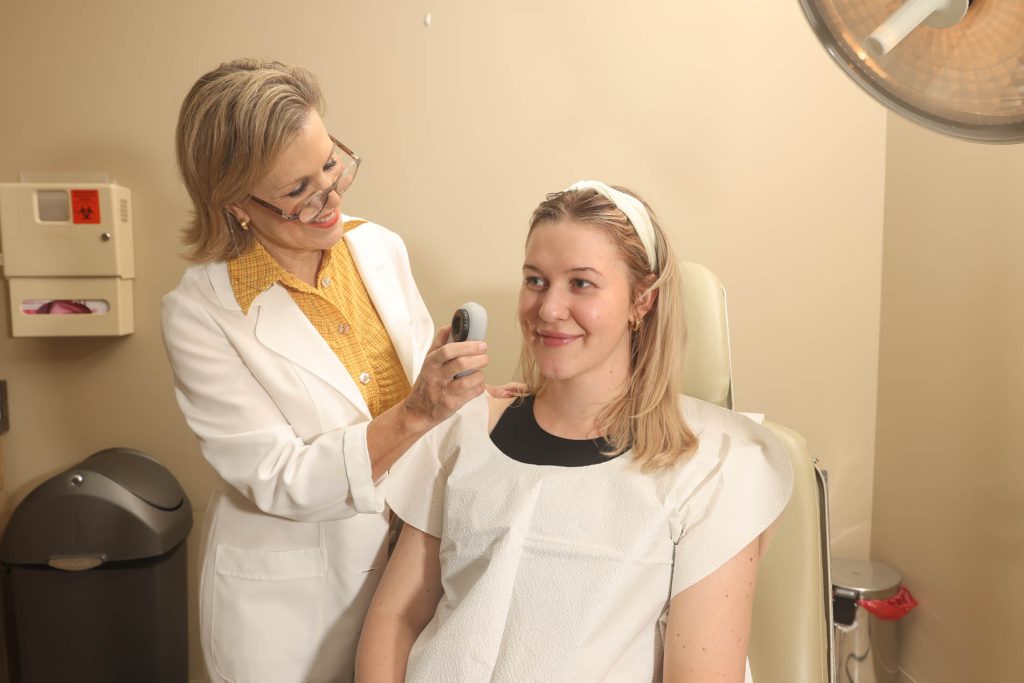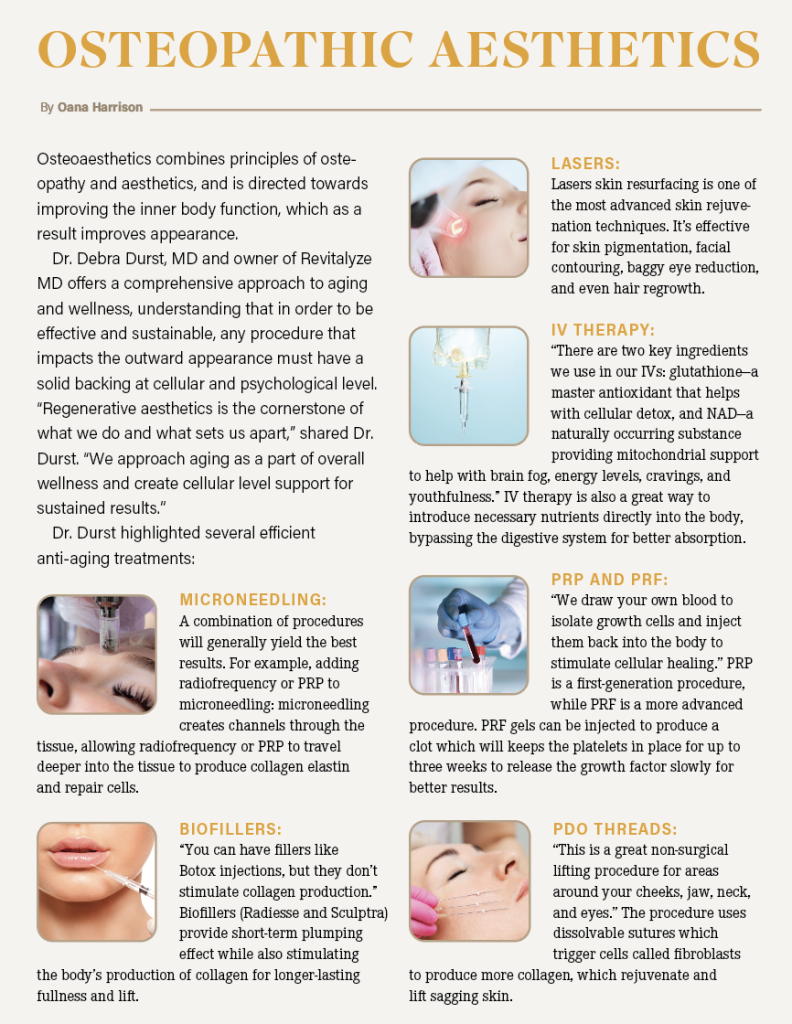“Your face is marked with lines of life, put there by love and laughter, suffering and tears. It’s beautiful.” — Lynsay Sands
Just like with everything else, anti-aging skincare and any rejuvenation treatments should focus primarily on health, with “looks” being the secondary purpose.
Aging is a natural occurrence, and there is beauty in it. However, society can put pressure on us to pay extra attention to wrinkles and other imperfections that are normal as we age. Lucky for us, there is a plethora of over the counter and professional help to assist us in rejuvenating ourselves inside and out.
“We live in a time where the ability and choices in aesthetic care are greater than they ever have been before,” shared Dr. Tom Gallaher, board-certified plastic surgeon and founder of Gallaher Plastic Surgery & Spa. “However, in my opinion, the individual seeking these treatments should be driven by their own goals and not by external factors or peer pressure.”
The Normal Aging Process
Once again, let’s ask: what are the normal effects of the aging process on our appearance? And, more importantly, what are the factors that contribute to skin health? Skin is one of the largest organs of our body (accounting for 15% of our body weight and covering about 20 square feet!) and its health is affected by intrinsic and extrinsic factors. Intrinsic factors include DNA, buildup of damaging products of cellular metabolism, and increasing biological aging of the cells. Extrinsic factors are environmental and behavioral elements such as exposure to sun and UV radiation, hydration, nutrition, stress, lack of sleep, and exposure to toxins in tobacco and alcohol.
Normal aging effects are diminished skin elasticity (collagen loss) and hydration (loss of hyaluronic acid), thinning of the epidermis (surface layer of the skin), increased bruising potential and sagging (due to fatty tissue loss under the skin and thinning of the blood vessel walls), dry skin (less hyaluronic content and sebum production), and of course wrinkles.

How to Fight the Aging Process
In our previous article, The Search for the Fountain of Youth Begins at Home, we discussed at-home care and daily habits to help us age well. But when should we start a skincare routine? According to specialists, a healthy routine should start as early as childhood. This doesn’t mean applying cosmetics or doing anything extreme, but simply building good habits that protect our skin from damage.
As we age, we can help our outer appearance look healthier through skincare products and daily routines; aesthetic medicine such as injectables (fillers; mesotherapy), laser treatment, chemical peels, or cryogenics (cool sculpting); plastic surgery; or osteoaesthetics (focused on improving the inner body function which translates outwardly on improved appearance). Let’s examine each option and hear from local Knoxville area experts on how they can help.
Skincare
A good basic skincare routine is the best starting point. During childhood, the focus should be on hygiene, hydration, and damage protection—use a gentle cleanser, moisturizer, and sunscreen. As puberty hits, so do pimples, most likely. Adjust the cleanser and add spot treatments with salicylic acid. In our 20s we should up our regime to include anti-aging products such as antioxidant serums and creams. Start adding retinol and retinoid products into the skincare routine in our 30s and 40s, which along with antioxidants, will fight off fine lines and wrinkles.
Be aware to use retinoid products carefully and as a part of your nightly routine, as they increase skin’s sensitivity to sunlight, thus making it more vulnerable for sun damage.
For mature skin, address the loss of collagen and hyaluronic acid, as well as skin damage. This is when we bring our A game. It’s important to understand what aging effect we want to target so we choose the right products and not get lost in the myriad of options touting miracle cures (spoiler alert: there are none).
Before choosing a skincare regimen, it’s important to understand your skin type and specific skin health issues you might have, so it’s wise to consult a dermatologist. Dr. Meredith T. Overholt, MD, FAAD, board-certified dermatologist and founding partner of The Skin Wellness Center cautioned against following self-made social media skincare experts, pointing out that, although well-meaning, the social media advisors usually don’t have the proper expertise.
“The biggest thing to keep in mind is that topical things work very well on the epidermis, the outer layer of the skin, on some disorders of pigmentation, and certain fine lines and wrinkles. The goal of topical therapy ought to be to address those things. When you see a topical product that’s claiming to help with deep lines and wrinkles, you’re probably going to end up disappointed,” Dr. Overholt concluded.
She pointed out that skincare is a very personal matter—there is not a “one-size-fits-all” solution. Dr. Overholt added: “Our practice has been looking at people’s skin for many years, addressing medical issues as well as cosmetic ones. Skincare is personal and customizable care. What we ultimately recommend is based on the level of involvement people want and a doctor’s opinion.”

Certain skin tones and genetics are more prone to certain skin conditions than others. In addition, many of the off-the-shelf skincare products are less potent than medical grade ones offered by dermatologists or skin care specialists. “You can go to the store and buy something that has retinol or hyaluronic acid but the problem with non-physician dispensed product lines is that they don’t have the same FDA scrutiny on consistency of ingredient percentages,” explained Dr. Gallaher. “When you work with a specialist, it’s almost like having a personal trainer for working out: you get customized expert guidance.”
A good routine will include a hydrating cleanser, exfoliator (scrub), toner, serum, moisturizer, sunscreen, and face mask; it incorporates vitamin C (antioxidant), vitamin A/retinol (fights hyperpigmentation, dark spots, wrinkles, and increases collagen), antioxidants (help with hyperpigmentation and wrinkles), niacin (helps balance sebum production, improves water retention, and skin elasticity), hydroxy acids (increase cell turnover and stimulate new skin cell growth), and hyaluronic acid (hydrates the skin and boosts hyaluronic acid production).

Aesthetic Medicine
Aesthetic Medicine refers to medical procedures aimed at improving physical appearance using non-invasive to minimally invasive cosmetic procedures. The most common cosmetic procedures for aging skin are: photorejuvenation, injections of Botulinum toxin (Botox), injection of dermal fillers, mesotherapy injections (injections of pharmaceutical preparations, enzymes, hormones, plant extracts, vitamins, and/or other ingredients such as hyaluronic acid), chemical peels, microdermabrasion, microneedling, laser treatments, and cool sculpting (cryolipolysis). Let’s talk briefly about each one.
Photorejuvenation uses Intense Pulsed Light (IPL) technology to reduce the appearance of common skin concerns, such as sunspots, age spots, melasma, broken capillaries, and wrinkles. This minimally invasive procedure requires little recovery time and has few side effects.
Injections vary in substance contained and effect duration. The most common derma fillers for injectables are: hyaluronic acid (HA), Calcium hydroxylapatite (CaHA), Poly-L-lactic acid, Polymethylmethacrylate (PMMA), and autologous fat injections. Except for PMMA, they are naturally occurring substances. HA injections plump and hydrate the skin for 6 to 18 months. CaHA injectables stimulate natural collage production, with effects lasting longer than HA (about 12 months), for deeper lines and wrinkles. Poly-L-lactic acid is as a collaged stimulator which can smooth deeper facial wrinkles for more than 2 years. A combination of collagen and a synthetic yet biocompatible substance, PMMA provides continuous skin support and firmness. Autologous fat injections put our own fat to good use: fat gets harvested via liposuction, purified, then injected in areas such as cheeks and lower lids to provide a more youthful look.
What are some things to consider before choosing any aesthetic medicine procedures? Do your research: know what is FDA-approved, understand the side effects, and find a qualified provider. “There is no right or wrong. When it comes to making a treatment decision, it depends not only on a person’s particular skin issues but also on their budget, pain tolerance, and downtime available for recovery,” said Dr. Overholt. She also noted that skin health should be the main reason for any procedure, which has been historically where dermatologists came in.
The Bottom Line
Despite the amount of outside pressure, keeping our health and wellness, and your own personal desires, front and center is essential when approaching anti-aging and aesthetic treatments. “From sunscreen and moisturizers to advanced physician dispensed skincare, to neurotoxins and fillers to laser treatments to surgical procedures, the patient should be educated and given choices that allow them to be driven only by their desire to look and feel more youthful and heathier,” concluded Dr. Gallaher. “In other words, these treatments are at their best when the patient has them as a gift to themselves.”
